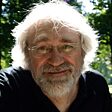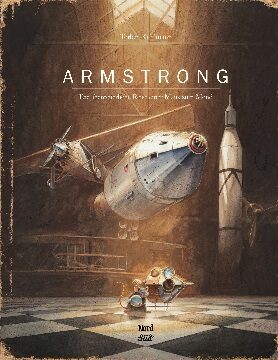Torben Kuhlmann
Armstrong. Die abenteuerliche Reise einer Maus zum Mond
[Armstrong. The Adventurous Journey of a Mouse to the Moon]
- NordSüd Verlag
- Zürich 2016
- ISBN 978-3-314-10348-3
- 128 Pages
- 5 Suitable for age 6 and above
- Publisher’s contact details
Sample translations
Top secret!
A mouse travelling to the moon in a tiny home-made spaceship? Surely this can only be a picture book for young children?! After all, we somewhat older folk long since stopped believing that the moon is made of cheese.
Well, no - not if the young writer and illustrator Torben Kuhlmann is anything to go by. Already in his debut book Lindbergh, Kuhlmann chose a flying mouse as his hero, in the process scoring a much lauded success as a master of photo-realistic book-illustrating; and now in his third picture book on the adventures of space-travelling mice he has gone so far as to create a fictional but nonetheless convincingly narrated and illustrated prequel to man’s first landing on the moon on 21 July 1969.
What Kuhlmann tells his utterly flabbergasted readers seems altogether sensational - namely that only a tiny number of people back then were in the know about the existence of a moon mouse! And NASA’s top secret codename for this mouse was ‘Armstrong’. ‘This ensured that no one could inadvertently betray the secret. Whenever there was any discussion about the first visitor to the moon, the answer was simple: "It was Armstrong". ’
The biography of our hero as put to us by Kuhlmann is even more startling than the sheer fact that man was beaten to it by a mouse. For the moon mouse is a very special creature: highly gifted, curious, thirsty for knowledge, full of ideas, skillful with his hands, courageous, and in the face of adversity unshakeably true to his dreams and his mission. With his realist drawing style and fascinating perspectives Kuhlmann the illustrator takes us straight into 1950s America: World War Two is over, and in its place are years of explosive economic and techno-scientific development, and an all-pervading ‘Can do!’ mentality.
And right there, in an attic room in downtown Manhattan, we encounter a tiny picture-book mouse, perched on top of a stack of old books, staring intently - and, if we’re not much mistaken, somewhat dreamily - through a telescope. Thus begins a weird and wonderful illustrated tale that on one level appears to be taken straight from real life, yet is viewed from the perspective of a small rodent. We witness an assembly of mice in a cheese shop, at which our hero tries in vain to explain to his fellow creatures the exciting things he has found out about the moon in his unquenchable thirst for knowledge. It is only when a mysterious letter arrives from the world-famous National Air and Space Museum at the Smithsonian Institute that possibilities open up for the mouse that previously he could only dream about. A venerable old mouse-inhabitant of the Museum tells him how mice as well as men had long been gripped by a fascination for flight. Our hero’s decision is made: ‘I shall be the first mouse on the moon.’ And with this decision, numerous doors - or rather mouse-holes - are opened up for him onto strange new worlds. He secretly studies at university. By dint of a lengthy period of arduous, painstaking work he contrives to produce a space suit, a space capsule and a catapult. His venture fails, he tries again, he fails again, but he refuses to give up, until - yes! - one day...
Numerous scenes in the wildly adventurous life of this mouse simply take our breath away. It’s as if we are being plunged into the world of America via the medium of a Hollywood film in Cinemascope and full technicolour. Kuhlmann creates images that draw us in with tremendous power, even though - or perhaps precisely because - their style and their message both derive from a deep commitment to realism. However, this doesn’t mean that the story is devoid of the fantastical and its attendant magic. The magic comes through in the subtle insights we are offered, it manifests itself in seemingly unimportant details within the drawings, in unexpected perspectives, and not least in the mouse’s somewhat dreamlike air as he gazes up at the night sky.
If this fantastic-realistic take on the excitement of pursuing science and making new discoveries doesn’t encourage inquisitive children to engage with the world beyond their immediate horizon, what will?!
Translated by John Reddick

By Siggi Seuß
Siggi Seuß, freelance journalist, radio script writer and translator, has been writing reviews of books for children and young people for many years.
Publisher's Summary
America in the 1950’s . . . When the other mice all fall victim to a highly unscientific cheese cult, one inquisitive little mouse observes the moon through a telescope each night. Can the moon really be made of cheese? Inspired by the pioneering work of an old wise mouse, the little mouse decides to answer this question once and for all. He makes a big decision: He will be the first mouse to fly to the moon!
In his second big adventure about a little mouse, Torben Kuhlmann demonstrates his full mastery, both as an illustrator of impressive atmospheric pictures, but also as a clever and exciting storyteller. His loving eye for detail proves utterly persuasive.
(Text: NordSüd Verlag)
